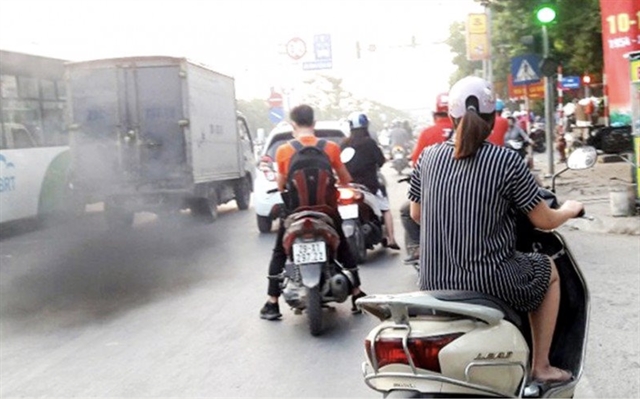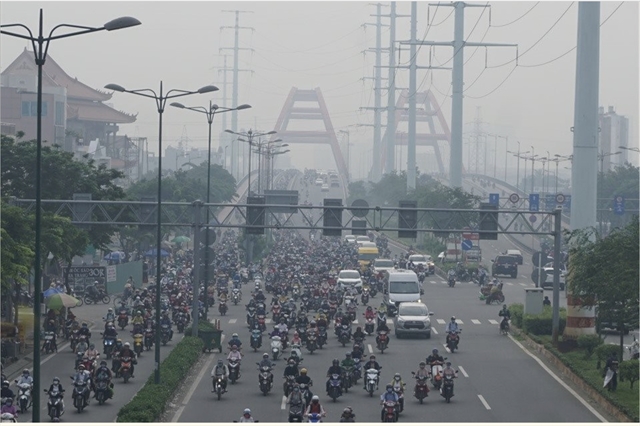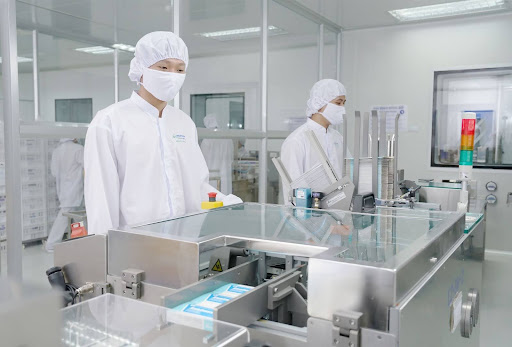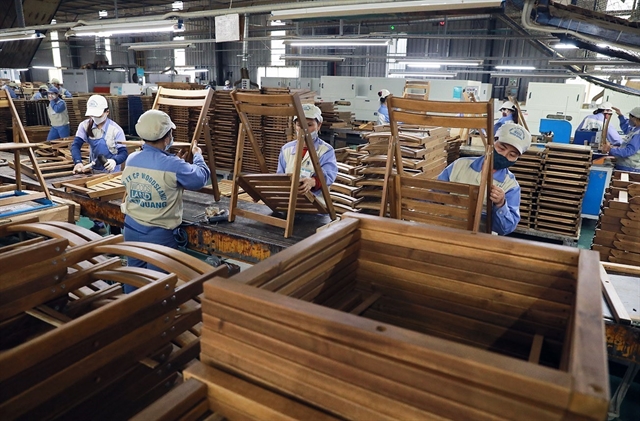 Environment
Environment

 |
| The capital city's main source of dust emissions comes from road vehicles and road dust. — Photo moitruong.net.vn |
HÀ NỘI — The rapid urbanisation process, coupled with the overload of residents and vehicles, has made air pollution a 'crisis' for big cities of Hà Nội and HCM City.
People living in central Hà Nội are probably too familiar with the air quality, which often resembles a misty haze. Whether it is day or night, the residents of the capital must live with air pollution.
Monitoring data shows that Hà Nội’s air quality index (AQI) frequently shows high levels with orange, red, purple and even brown indicators, showing on monitoring applications.
In some instances, Hà Nội has been ranked as one of the top three most polluted cities in the world.
Air pollution has become so severe that residents can actually feel it.
Living on the 21st floor of a high-rise building in Thanh Xuân District, Hoàng Thị Trang told moitruong.net.vn that she almost never dares to open her windows in the early morning, even in the middle of summer.
Many times when she opened the windows to let in sunlight, she was disappointed to find an oppressive, thick atmosphere, making it difficult to breathe and very uncomfortable.
That is on dry days, but on humid days, people in the capital are even more frustrated and sick with air pollution.
Nguyễn Văn Sơn, a resident in Hà Đông District said that his three-year-old son frequently has to be hospitalised for respiratory illnesses.
Sơn said that the air pollution in Hà Nội is so bad that he is worried about the health of his children and elderly parents. Even on dry days, his son’s bronchitis only lessens but never completely goes away.
HCM City is not far behind when it comes to air pollution. From early morning until noon, walking along the streets, the people suffer with the air shrouded in a thick layer of smog.
According to experts, this is a common phenomenon in the southern region at the end of the year, during the transition period between the rainy and dry seasons.
This phenomenon, termed 'photochemical smog' has been reported by the City’s Department of Natural Resources and Environment.
Major cities are constantly grappling with the persistent issue of smog and pollution, with the overwhelming number of vehicles and the large population all contributing to a highly polluted atmosphere.
In reality, PM2.5 particles — known as the silent killer — can penetrate deep into the lungs despite the use of multiple layers of masks, causing numerous respiratory and cardiovascular diseases, particularly among sensitive groups like the elderly and children.
 |
| The people in HCM City suffer, with a thick layer of smog. Photo moitruong.net.vn |
Main causes
According to the Ministry of Natural Resources and Environment, air quality in large urban areas and some industrially developed cities continues to record pollution at certain times of the year, with dust pollution being a major concern.
The concentration of dust (PM2.5, PM10, and TSP) in some areas remains high, particularly along traffic routes, main roads and industrial zones in major cities.
Associate Professor, Bùi Thị An, director of the Institute for Environmental Resources and Community Development, said large cities are currently subjected to a vast amount of harmful emissions into the air. Among these, urban transportation and emissions from personal vehicles are the leading causes of air pollution in large cities.
Currently, in both Hà Nội and HCM City, motorcycles account for 95 per cent of the total number of vehicles, consuming only 56 per cent of fuel but emitting up to 94 per cent of hydrocarbons (HC), 87 per cent of carbon monoxide (CO) and 57 per cent of nitrogen oxides (NOx) in total vehicle emissions. The emissions of these gases increase annually in tandem with the rising number of vehicles on the roads.
Specifically, during traffic congestion, the level of fuel emissions can increase by four to five times compared to normal conditions.
Moreover, the quality of vehicles is also a concerning issue. Most of the old cars and motorcycles currently in circulation do not have emission control systems.
The second leading cause of air pollution in large cities is construction activities.
Each year, Việt Nam constructs tens of millions of sq.m of new housing, hundreds of kilometres of roads and dozens of medium and large bridges, which all generate large volumes of dust.
Along with construction, the demolition and destruction of old structures causes dust to spread across the sky.
The third cause of air pollution is from industrial and agricultural production.
Industrial zones and occupation villages not only cause air pollution, but are also a leading cause of water pollution, which has led to the emergence of what are being dubbed 'cancer villages'.
“The main reasons causing air pollution in Việt Nam is due to outdated production technology and low efficiency of using clean resources and energy,” said An.
“Particularly, it is because of the increase of personal vehicles and many of them are beyond their useful life and do not meet emissions regulations,” she said.
Chairman of the Việt Nam Clean Air Network Hoàng Dương Tùng said that although it is acknowledged that solving air pollution in major cities is no simple matter, we need to have a comprehensive and holistic view of both the root and branch of the issue.
This approach will help us identify specific and practical solutions that can significantly contribute to reducing air pollution in large cities, Tùng said.
Solutions
Faced with increasingly concerning air pollution, Hà Nội has continuously implemented measures to mitigate air pollution.
The city is building a mechanism to encourage co-operatives to adopt clean production models, support funding for straw processing products, purchase straw-pressing machines and introduce cooperative models for collecting straw after harvests. This helps reduce air pollution significantly.
Hà Nội’s Department of Transport has been tasked with implementing: “zoning restrictions on motorcycle activities in line with infrastructure capacity and the public transport system’s service capability, leading to a complete ban on motorcycles in urban districts by 2030.”
According to data from the Department of Natural Resources and Environment (DoNRE), Hà Nội has eliminated more than 99 per cent of coal-burning stoves, reduced eighty per cent of straw burning in suburban areas and shut down hundreds of manual brick kilns.
Furthermore, the city has introduced a network of 34 automatic air quality monitoring stations and six surface water monitoring stations to supervise the environmental quality of industrial zones and production facilities.
Recently, the People’s Committee has approved the air quality management plan for Hà Nội until 2030, with a vision towards 2035 and an orientation until 2050.
The city will minimise air pollution, ensuring that air quality remains at a good to moderate level on the AQI for at least 75 per cent of the days in the year by 2030 and reduce PM2.5 emissions from major sources, with an overall reduction of about twenty per cent of PM2.5 levels compared to the base year of 2019, equivalent to a reduction of 6,200 tonnes of PM2.5.
Meanwhile, HCM City has also issued a plan to enhance air pollution control for the 2024–2025 period.
This plan aligns with the national air quality management plan for 2021–2025, tailored to the city’s economic and social development goals.
The overall objective of the plan is to strengthen air quality management by controlling emissions, monitoring air quality and issuing forecasts and warnings, thereby improving the environment and safeguarding public health.
HCM City aims reduce 85 per cent of air pollution caused by transport, ensure at least 90 per cent of construction projects to comply with environmental protection regulations and all large-scale industrial facilities install automatic emission monitoring equipment, with data connected directly to DoNRE.
Planting more trees has also proven to be an effective solution for improving air quality in the city. So the city aims to plant ten million trees by 2025, in line with the national plan to plant one billion trees by 2025.
Experts believed that city’s green economic development goals and Việt Nam’s commitment to net-zero emissions depend heavily on transitioning transportation to clean energy.
Focusing on green transport will help reduce air pollution and contribute to environmental improvement efforts and public health protection.
The city is gradually developing a public transport system to reduce personal vehicle use and reach a target of all public transport vehicles running on electric energy from 2030 onwards.
Stricter emission control policies for motorcycles and cars, particularly older vehicles that fail to meet emissions standards will be widely carried out.
According to DoNRE, by the end of 2023, the city’s environmental monitoring network included 271 manual monitoring stations, 34 of which are located in areas bordering neighbouring provinces. There are also four continuous automatic monitoring stations for surface water and air quality.
Monitoring activities have been carried out systematically, ensuring compliance with environmental monitoring procedures, thereby providing a comprehensive and timely assessment of environmental quality and reliable data for air quality management. VNS




